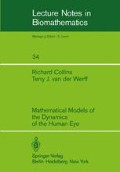Abstract
In this monograph the important fluid mechanical and viscoelastic aspects of ocular dynamics have been presented, with the main interest centering on the regulation of intraocular pressure. Aqueous humour formation and outflow rates largely determine the state of equilibrium achieved. Neural control, not extensively covered here, probably acts through vasomotor adjustment of the ocular blood flow, which is coupled to both aqueous formation and outflow.
Access this chapter
Tax calculation will be finalised at checkout
Purchases are for personal use only
Author information
Authors and Affiliations
Rights and permissions
Copyright information
© 1980 Springer-Verlag Berlin Heidelberg
About this chapter
Cite this chapter
Collins, R., van der Werff, T.J. (1980). Summary and Conclusions. In: Mathematical Models of the Dynamics of the Human Eye. Lecture Notes in Biomathematics, vol 34. Springer, Berlin, Heidelberg. https://doi.org/10.1007/978-3-642-50153-1_7
Download citation
DOI: https://doi.org/10.1007/978-3-642-50153-1_7
Publisher Name: Springer, Berlin, Heidelberg
Print ISBN: 978-3-540-09751-8
Online ISBN: 978-3-642-50153-1
eBook Packages: Springer Book Archive

